
You walk into any gym, and there it sits in the corner like a piece of abandoned equipment – the leg extension machine. Maybe you’ve even been told by a trainer or PT to “stay away from that thing.”
But what if I told you that this universally feared exercise might be safer than the squats everyone’s pushing you to do instead?
I know, I know. It sounds crazy. Every physical therapist worth their degree warns against leg extensions. Your trainer probably steers you toward squats and lunges instead. But here’s the thing – recent research is flipping this conventional wisdom on its head.
And we’re talking about serious money here. Knee surgery costs are exploding from $2.7 billion to a projected $13 billion annually by 2030. With stakes this high, shouldn’t we make sure we’re getting the science right?
Let’s dive into one of fitness’s biggest controversies and uncover what’s happening.
Why Every PT Says “Don’t Touch That Machine”
🚨 The Physical Therapy “Danger Zone” Checklist
Walk into any physical therapy clinic and ask about leg extensions. You’ll get the same response everywhere.
“Sure, you can go back to the gym, but stay away from that knee extension machine,” warns Paul Kochoa, PT, DPT, OCS.
The reasoning sounds pretty scary when you break it down:
- Massive lever arm forces: Your ankle is way out there from your knee, creating huge stress
- Kneecap compression: All that force gets concentrated on your poor patella
- Shear stress on ligaments: Your ACL gets pulled in ways it doesn’t like
- Unnatural movement: When do you ever extend your leg like this in real life?
Dr. Joseph Horrigan puts it bluntly: “The leg extension places maximum force on the back of the patella, the thinnest portion of the cartilage.”
Makes sense, right?
The experts paint a picture of this exercise as a knee-destroyer, focusing all that stress on the weakest parts of your joint while your hamstrings just sit there doing nothing to help stabilize things.
But Here’s Where It Gets Interesting…
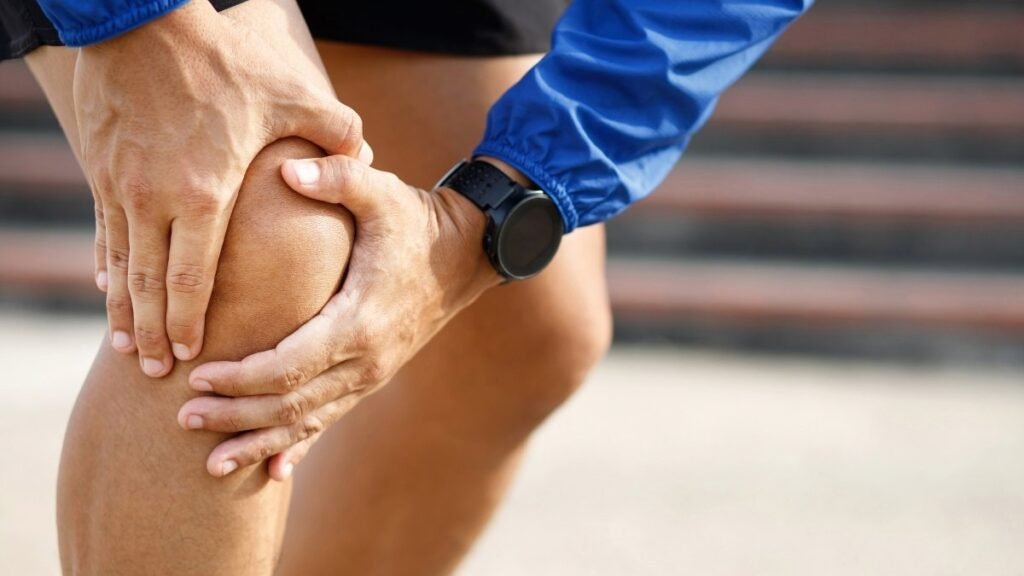
Remember how I said recent research is changing everything?
Studies from 2020-2025 are showing something that’s making a lot of people uncomfortable: leg extensions might put LESS stress on your knees than squats.
Wait, what?
Let me break this down for you:
The ACL Scare Tactics Don’t Add Up
Everyone freaks out about ACL stress during leg extensions. But when researchers measured the forces, here’s what they found:
- Leg extensions create 177-350 Newtons of force
- Your ACL doesn’t fail until 1,745 Newtons
- That’s like worrying about a paper cut when you need a chainsaw to do damage
The actual strain on your ACL during leg extensions? Less than 4.4%. You need 10% to cause problems.
The Kneecap Stress Story Gets Flipped

This one surprised me. Dr. Powers’ research shows that patellofemoral stress is HIGHER in squats compared to seated leg extensions in that 90-45° range everyone works in.
Think about it – when you’re squatting, you’re loading your knee with your entire body weight plus whatever’s on the bar. During leg extensions, you’re typically using much lighter resistance.
Your Hamstrings Aren’t Lazy After All

One of the biggest knocks against leg extensions is that your hamstrings don’t fire to help stabilize.
Turns out that’s not entirely true either. Recent EMG studies show you can boost hamstring activation by 2-4 times during leg extensions just by consciously engaging them.
And here’s the kicker: When you do this with moderate resistance (30% of your max), it eliminates those scary shear forces everyone warns about.
The Mind-Blowing Economics Behind the Fear
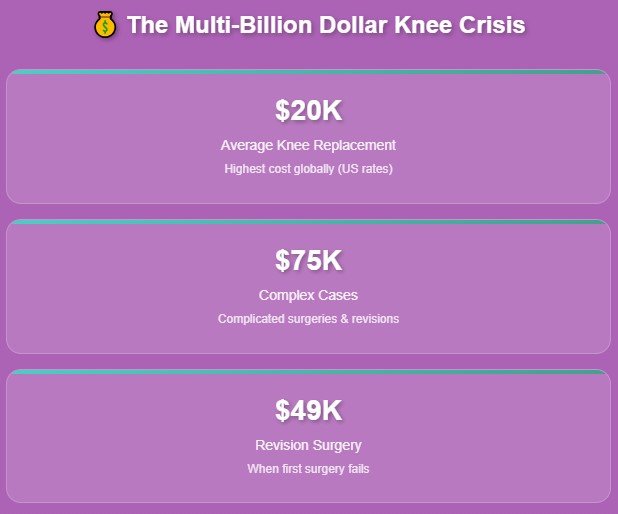
Let’s talk money for a second, because this explains a lot about why everyone’s so paranoid about knee injuries.
The average knee replacement in the US costs $20,000. Complex cases? Try $75,000.
We’re talking about 700,000 surgeries in 2010, jumping to a projected 3.8 million per year by 2030. That’s more than a 5x increase!

And if that first surgery doesn’t work out? Revision surgeries average $49,360 each.
But here’s what gets me – 37% of knee replacements now happen before age 65. We’re talking about people in their prime working years getting major surgery.
No wonder everyone’s terrified of anything that might hurt your knees. The financial consequences are massive.
The Hidden Costs You Don’t Think About
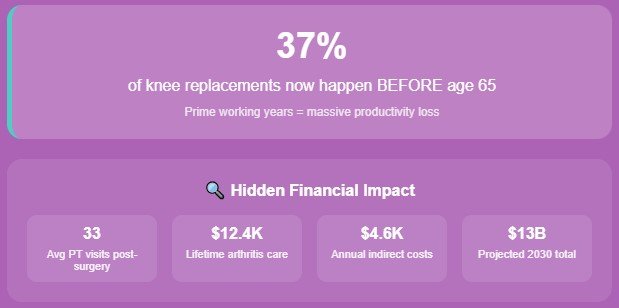
Beyond surgery, there’s the rehab:
- Physical therapy: $160-$3,600 depending on your insurance
- Average of 33 PT visits post-surgery
- Lifetime care costs for knee arthritis: $12,400 per person
Plus all the work you’ll miss, the activities you can’t do, the quality of life impact…
With numbers like these, I get why PTs err on the side of extreme caution.
Who Gets Hurt (The Results Might Surprise You)
🎯 The Surprising Truth About Who Gets Injured
Before we decide if leg extensions are dangerous, let’s look at who’s getting injured and how.
The Gender Puzzle
Women face some serious disadvantages:
- 3x higher ACL tear rates than men
- 4-6x more likely to get seriously injured running
- But 25% LESS likely to get hurt in the gym overall
That last one is interesting. It suggests controlled environments (like using machines) might be safer for women than dynamic activities.
Age and Experience Matter More Than You Think
The highest knee injury rates? Ages 15-24 at 3.83 per 1,000 people.
But chronic knee pain tells a different story:
- 18% of adults aged 18-44 have knee pain
- 23% for ages 45-64
- 37% for over 65
And here’s a stat that should make every beginner pay attention: 80% report at least one gym injury in their first year.
The problem isn’t necessarily the exercises – it’s often inexperience, poor form, or doing too much too soon.
What Happens Inside Your Knee
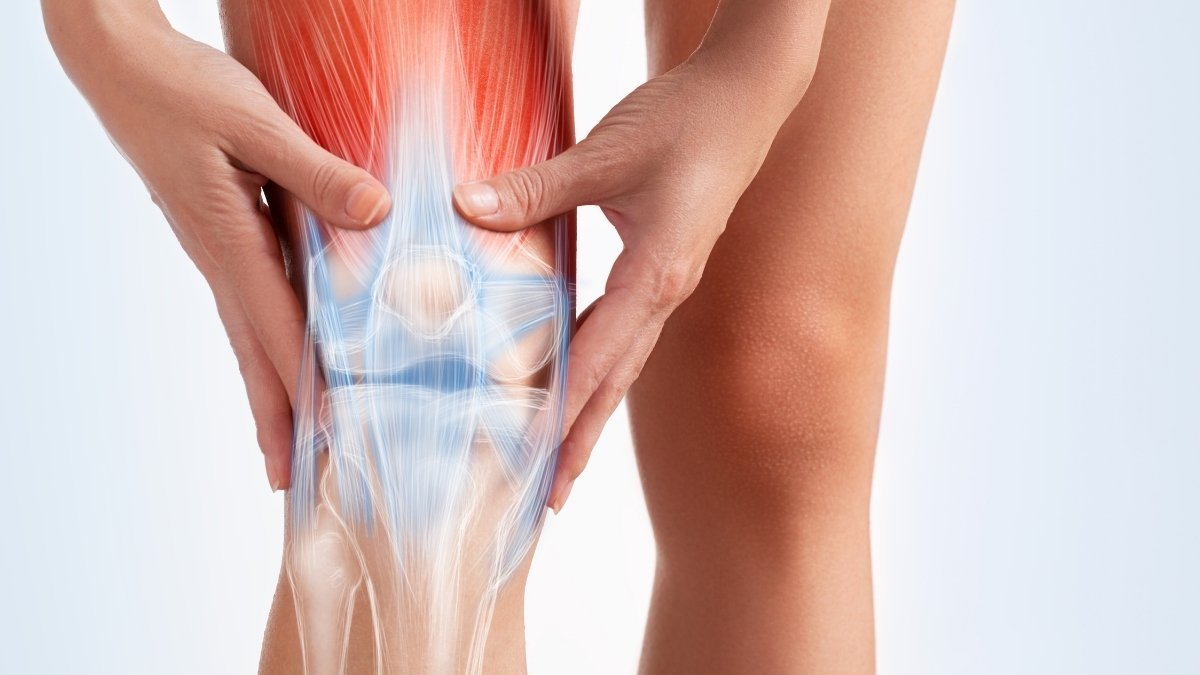
Okay, let’s get a bit technical (but I’ll keep it simple).
When you do leg extensions, several things happen:
The Good:
- Your quadriceps get isolated strengthening
- Forces are controllable and predictable
- The range of motion can be limited to safer zones
Concerning:
- The contact area on your kneecap decreases as you straighten your leg
- Forces concentrate on smaller cartilage surfaces
- Resistance applied at your ankle creates a long lever arm
But here’s the key insight from recent research: joint reaction forces are minimal at 90° knee flexion during leg extensions.
The problems mainly show up in that final 30° of extension, where your kneecap contact area is smallest.
Translation: The exercise isn’t inherently dangerous – it’s about HOW you do it.
The Reality Check: Where Are All These Injuries?
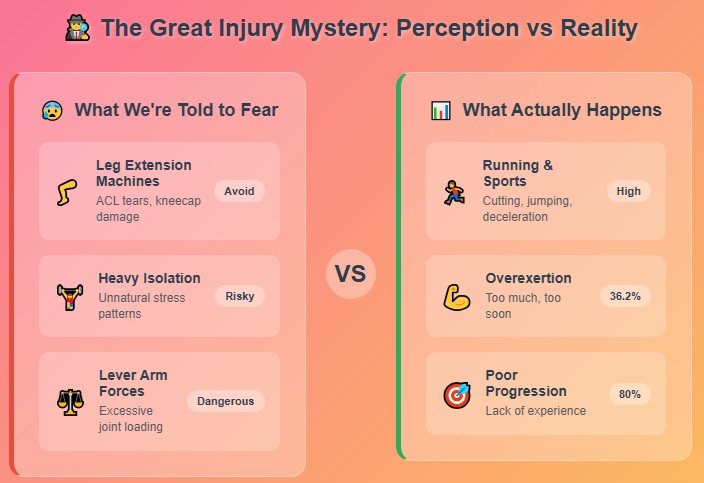
If leg extensions are so dangerous, where are all the ACL ruptures from using the machine?
They basically don’t exist in recent medical literature.

Real ACL injuries happen during:
- Sudden deceleration
- Jumping and landing
- Cutting movements in sports
- Not controlled machine-based exercises
Most “leg extension injuries” are overuse problems from doing too much volume or using too much weight, not acute injuries specific to the exercise itself.
The Rehab Plot Twist

Here’s something that might blow your mind: Multiple studies show leg extensions are EFFECTIVE for treating patellar tendinopathy (jumper’s knee).
Wait, so this “dangerous” exercise is being used successfully in rehabilitation?
Yep. When done properly, it helps strengthen the exact muscles that need work without the chaos of compound movements, where you might compensate with other muscle groups.
How the Recommendations Are Evolving

The fitness industry is slowly catching up to science.
Modern physical therapy doesn’t say “never do leg extensions.” Instead, it’s about smart application:
The New Approach:
- Limit range of motion – avoid that final 30° of extension
- Use higher reps with lighter weights – think 15-20 reps instead of 5-8
- Control the tempo – slow and controlled beats, fast and jerky
- Focus on muscle contraction quality over how much weight you can move
Equipment Is Getting Smarter Too:
- Range of motion limiters
- Variable resistance systems
- Better biomechanics that match natural knee motion
The key insight: It’s not about avoiding the exercise – it’s about doing it intelligently.
What This Means for You

So, where does this leave you as someone just trying to build strong, healthy legs?
If You’re Currently Avoiding Leg Extensions:
You might be missing out on a valuable tool for quad strengthening, especially if you:
- Have trouble feeling your quads work during squats
- Are you rehabbing from an injury
- Need isolated strengthening for muscle imbalances
If You’re Already Doing Them:
Keep doing them, but be smart about it:
- Start light and focus on form
- Avoid the final 30° of extension (don’t lock out completely)
- Higher reps, moderate weight
- Conscious hamstring engagement
If You’re Unsure:
Consider your goals and situation:
- For general fitness: Squats and lunges are probably sufficient
- For targeted quad weakness: Leg extensions might be exactly what you need
- For injury history: Work with a qualified professional
The Bottom Line
This whole leg extension controversy teaches us something important about fitness advice: be skeptical of absolute statements.
The exercise isn’t inherently good or bad – it’s a tool. Like any tool, it can be used properly or improperly.
What matters most:
- Your individual needs and goals
- Proper form and progression
- Understanding your own body’s response
- Working within appropriate parameters
The science is evolving, and our recommendations should evolve with it. Maybe it’s time to stop demonizing an exercise that, when used intelligently, might help more people than it hurts.
Your Next Steps
- If you’re curious about leg extensions, start conservatively with light weight and a partial range of motion
- Focus on movement quality over the numbers on the weight stack
- Listen to your body – any pain means stop and reassess
- Consider working with a knowledgeable trainer who understands both the benefits and limitations
The fitness industry loves black-and-white rules because they’re easy to follow. But your body is more complex than that.
Maybe it’s time we started treating it that way.
What’s your experience with leg extensions? Have you been avoiding them, or do you include them in your routine? Share your thoughts – I’d love to hear how this information changes (or confirms) your approach to leg training.






